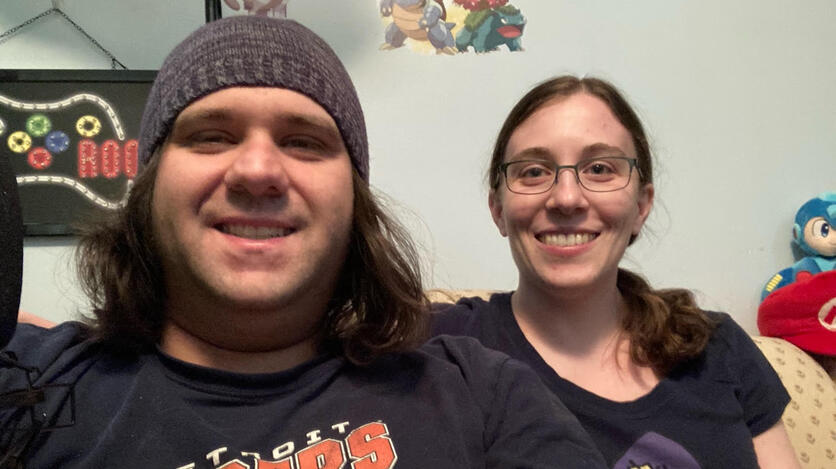
This article was originally published on May 24, 2021.
Professor Bruce Maxim hasn’t taken a sabbatical since 1998, but what he did with that last one is still reverberating through the computer science department. At that time, he was a visiting professor at UM-Ann Arbor and decided he’d spend some of his semester hanging out with a colleague who was heading up U-M’s fledgling video game design program. In those days, Maxim says not everyone was on board with video games living in academia, but Maxim instantly saw the merits and hatched a plan to bring something similar to UM-Dearborn. It was pretty simple at first: A single graduate course, Game Design I, which Maxim sold to colleagues as a novel “application area” for the software engineering master’s program. But it was an instant hit with the graduate students. Not long after, juniors and seniors started begging to get in, so they started an undergraduate course. An advanced class followed and then eventually a whole little mini-program that incorporated film and art classes from CASL, so students could get schooled in the balance of art, storytelling and coding that all great video games need.
The program at UM-Dearborn has always been small, but by a variety of measures, it’s always been successful. In the late-1990s, when UM-Dearborn would have been considered an early adopter, its program was ranked in the top 10 nationally. Within a few years, it boasted alumni like Austin Krauss ('05 M.S.), one of the developers of Call of Duty, one of the biggest video games ever. Even nowadays, in an era where Maxim says just about every college has some gaming curriculum, UM-Dearborn consistently earns a top 50 ranking. It still has a reputation as one of the stronger programs for coding and project management, when so many other colleges and universities have turned to game art.
What defines success for students in the gaming program varies quite a bit. Unlike many subjects in the College of Engineering and Computer Science, which route graduates toward specific careers, the path after game design is fluid. Today, Maxim says former students are finding their skills are in demand in the growing virtual reality space — as well as anything requiring simulation. (One graduate, for example, is now building simulations for NASA.) Even within gaming, there are multiple paths. Just as the internet’s disruption of the music industry meant artists no longer needed a major label or radio play to build an audience, people who want to build games don’t have to go work for or pitch their projects to the big companies. Maxim says app-based games now make up more than half of worldwide game revenue. And their free and open distribution through app stores means that anyone can build a game and get it out there if they have the skills, vision and determination to market it. Moreover, there is a growing niche market for indie games.
Choosing the life of an indie game developer offers more creative freedom, but it’s by no means an easy path. Just like artists and musicians, indie game designers often work day jobs while they build their own gaming companies. Two of Maxim’s graduates, Dustin Morabito (‘13 B.S.) and Lorraine (Ferraiuolo) Morabito (‘13 B.S.), who met at UM-Dearborn and later got married, have found a lot of happiness with this approach. When they graduated, they said they considered going to work in the industry, which would have meant more financial security. But it also would have required leaving the life they’d built together in southeast Michigan, where they both have family. Today, Dustin works as a freelance web developer; Lorraine, the artist of the duo, works as a part-time pottery decorator. It’s a work life that leaves them plenty of time to build Cubicorn Games, an independent game studio they founded in 2014.

Over the course of the past seven years, they’ve figured out a lot of what works and what doesn’t. Video games are a comprehensive media, requiring knowledge of soundtracks, sound effects, visual art, storytelling and coding, and as an indie gaming company of two, they’ve pretty much had to figure out all of that themselves. They’ve also learned a lot about marketing. “Similar to the music world, the avenues of distribution have made it so easy for anyone to do it, which means lots of people do it — to varying degrees of success and varying degrees of quality,” Lorraine says. “So it’s basically impossible to get ‘discovered’ on your own.” Rather than waiting for some game company to pick them up, they’ve poured their energy in grassroots networking: attending conferences, holding livestreams, hosting a podcast, and in general, participating in various parts of the indie gaming community where they’ll meet others who share their passions, their tastes, and who might also want to play their games.
These are the kinds of lessons learned they share now with today’s generation of students in Game Design I and II. Maxim has them back often as featured guests, where they’re honest about their ups and downs and defend the value of having a passion project in your life. “One of the main messages we share is that if your 10-year plan includes a big house and a nice car and two kids, then maybe you don’t want to bank on indie game development,” Dustin says, laughing. “But if you want to build games and this is your passion, there are ways where you can absolutely give it a shot. I mean 10 years from now, if the company is still just the two of us, but we’re putting out games that we’re proud of and some other people love to play, I’d be 100 percent happy with that outcome.”
###
Story by Lou Blouin. Interested in enrolling in the game design program? You can find more info on the official program page.



